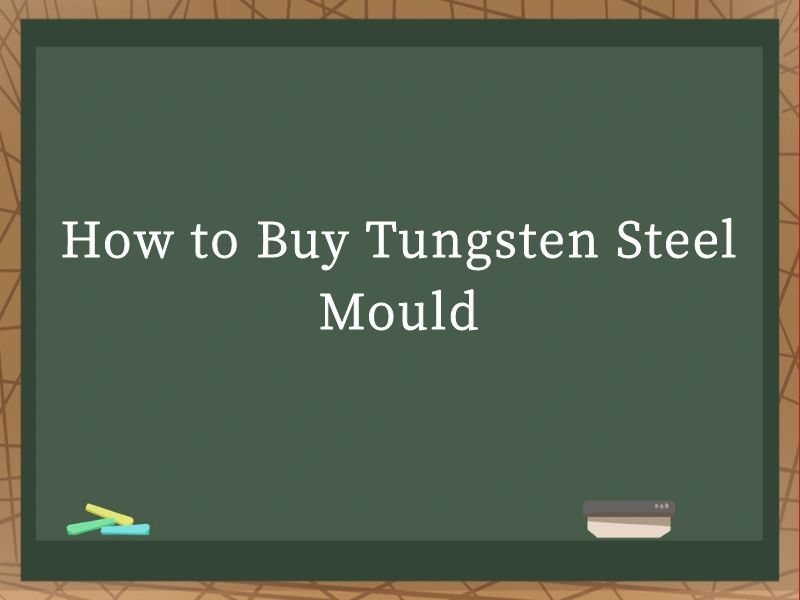JOURNALISM
- NEWS -
|
How to Buy Tungsten Steel MouldHow to Buy Tungsten Steel Mould.In the realm of manufacturing, tungsten steel moulds are renowned for their exceptional durability, hardness, and precision. These moulds are employed in a wide array of industries, from automotive and aerospace to electronics and medical devices, where they facilitate the production of intricate and high-quality components. Given their critical role in shaping various products, purchasing the right tungsten steel mould is paramount. However, navigating through the myriad of options and ensuring you make an informed decision can be challenging. This guide aims to provide comprehensive insights into the process of buying tungsten steel moulds, empowering you to make a well-informed purchase.
Understanding Tungsten Steel Moulds Before diving into the purchasing process, it's essential to have a foundational understanding of tungsten steel, also known as tungsten carbide. Tungsten carbide is a composite material composed of tungsten and carbon atoms bonded together in a crystalline structure. This material boasts a combination of properties that make it ideal for mould manufacturing: High Hardness: Tungsten carbide is one of the hardest materials on Earth, second only to diamond in terms of hardness. This hardness enables the moulds to withstand wear and tear, maintaining their shape and precision over extended periods. Wear Resistance: Due to its hardness, tungsten carbide exhibits exceptional wear resistance. This makes it suitable for high-volume production runs where consistent quality is crucial. High Density: Tungsten carbide's high density contributes to its excellent machinability and ability to maintain dimensional accuracy. Corrosion Resistance: It is highly resistant to corrosion, making it suitable for applications involving aggressive chemicals or environments. Thermal Stability: Tungsten carbide retains its hardness and strength even at elevated temperatures, ensuring stable performance in various thermal conditions. Identifying Your Needs The first step in purchasing a tungsten steel mould is to clearly define your needs. Consider the following aspects: Application: Determine the specific application for which the mould will be used. Different industries have distinct requirements in terms of precision, durability, and material compatibility. Production Volume: Assess the volume of production you anticipate. Tungsten steel moulds are often used for high-volume manufacturing due to their durability and precision. However, they may not be the most cost-effective option for low-volume or prototype production. Design Complexity: Evaluate the complexity of the design you need to produce. Tungsten steel moulds can handle intricate designs but may require specialized manufacturing techniques, which can increase costs. Budget: Establish a budget for your mould. Tungsten steel moulds are generally more expensive than those made from other materials due to their superior properties. However, their longevity and precision can offset the higher upfront cost. Lead Time: Determine the timeline for your project. Tungsten steel moulds can take longer to manufacture due to their complexity and material properties. Factor in this lead time to avoid delays in your production schedule. Selecting a Manufacturer Once you have a clear understanding of your needs, the next step is to select a reputable manufacturer. Here are some tips to guide you through this process: Experience: Look for manufacturers with extensive experience in producing tungsten steel moulds. Experienced manufacturers are likely to have a deeper understanding of the material's properties and manufacturing processes, leading to higher-quality moulds. Capability: Ensure the manufacturer has the capability to produce the specific type and size of mould you need. Look for manufacturers with a diverse portfolio of projects to gauge their versatility and expertise. Quality Control: Verify the manufacturer's quality control processes. High-quality tungsten steel moulds require precise manufacturing and rigorous testing to ensure they meet specifications. Customer Reviews: Read customer reviews and testimonials to gain insights into the manufacturer's reliability, customer service, and quality of work. Communication: Establish clear communication channels with the manufacturer. Effective communication is crucial for ensuring your requirements are understood and met. Specifying the Mould Design Working closely with the manufacturer, specify the detailed design of your tungsten steel mould. This includes: Dimensional Accuracy: Provide precise dimensions for the mould, including any tolerance requirements. Tungsten steel moulds are known for their precision, so ensure your specifications are clear and accurate. Material Composition: Specify the material composition of the mould, including the grade of tungsten carbide. Different grades offer varying levels of hardness, wear resistance, and thermal stability. Cavity Design: Detail the design of the cavity or cavities within the mould. This includes the shape, size, and number of cavities, as well as any undercuts or complex features. Gating and Venting: Describe the gating and venting systems for the mould. Proper gating ensures the molten material flows smoothly into the cavity, while effective venting prevents trapped air and porosity in the final product. Ejection System: Specify the ejection system for removing the moulded parts from the mould. This can include ejector pins, slides, or other mechanisms. Manufacturing and Testing Once the design is finalized, the manufacturer will proceed with the manufacturing process. This typically involves several stages, including: Material Preparation: The manufacturer will select and prepare the tungsten carbide material, ensuring it meets the specified grade and composition. Machining: The material will be machined to create the desired shape and features of the mould. This may involve milling, drilling, grinding, and other processes. Heat Treatment: The mould may undergo heat treatment to enhance its hardness and wear resistance. This involves heating the mould to a specific temperature and then cooling it rapidly. Polishing and Finishing: The mould will be polished and finished to ensure a smooth surface and remove any machining marks or imperfections. Assembly and Testing: The mould components will be assembled, and the complete mould will be tested to ensure it meets the specified dimensions, tolerances, and performance requirements. Inspection and Delivery Before finalizing the purchase, conduct a thorough inspection of the tungsten steel mould. This should include: Visual Inspection: Examine the mould for any visible defects, cracks, or imperfections. Dimensional Verification: Verify the dimensions of the mould using precision measurement tools to ensure they meet the specified tolerances. Functional Testing: Test the mould's functionality by running a trial production run. Evaluate the quality of the moulded parts for any defects or inconsistencies. Documentation: Ensure the manufacturer provides comprehensive documentation, including material certificates, inspection reports, and drawings. Once satisfied with the inspection, arrange for the delivery of the mould. Ensure proper packaging and handling to prevent damage during transportation. Purchasing a tungsten steel mould is a significant investment that requires careful consideration and planning. By understanding the material's properties, identifying your needs, selecting a reputable manufacturer, specifying the design, and conducting thorough inspections, you can ensure you receive a high-quality mould that meets your requirements. Remember, the quality of the mould directly impacts the quality of the final product, so take the time to make an informed decision to maximize your investment. |


